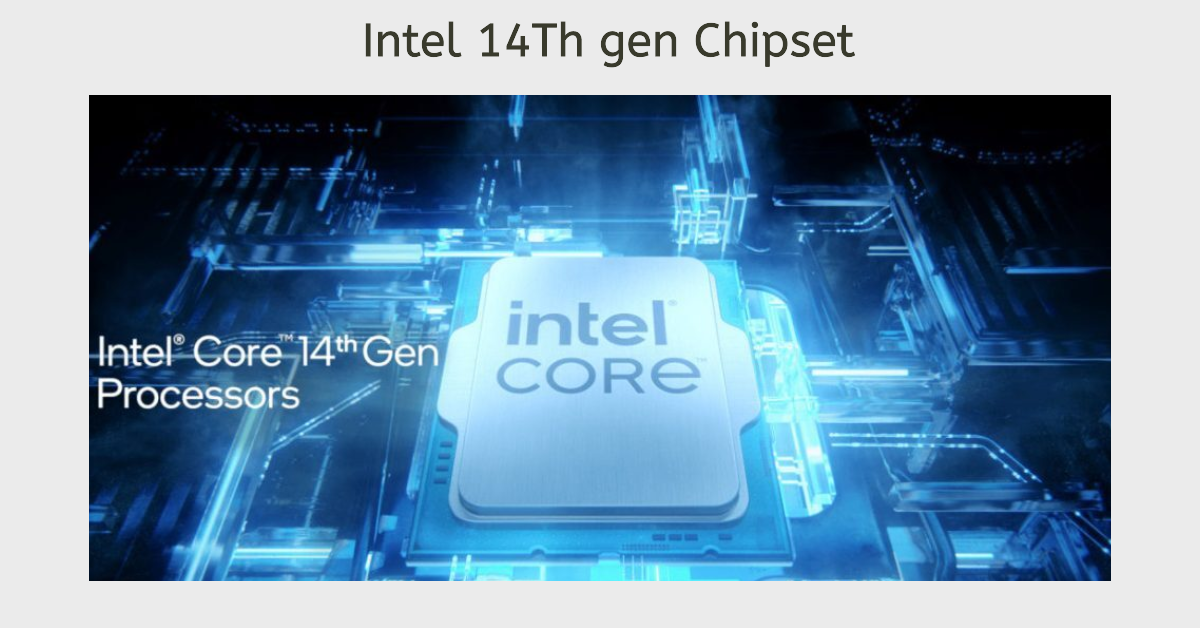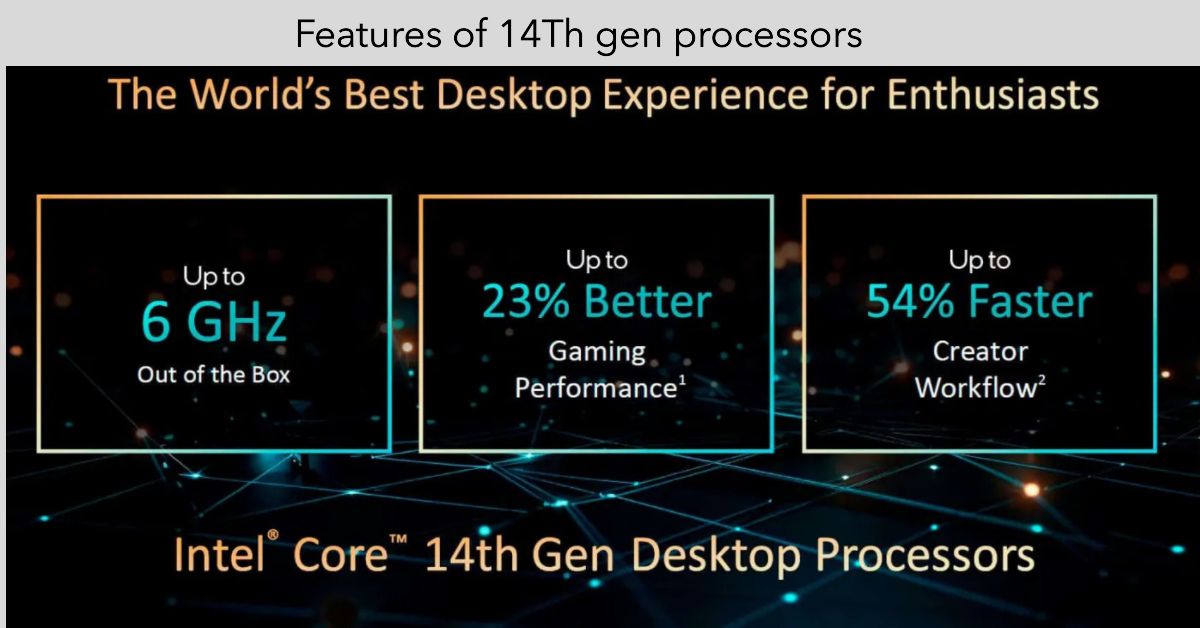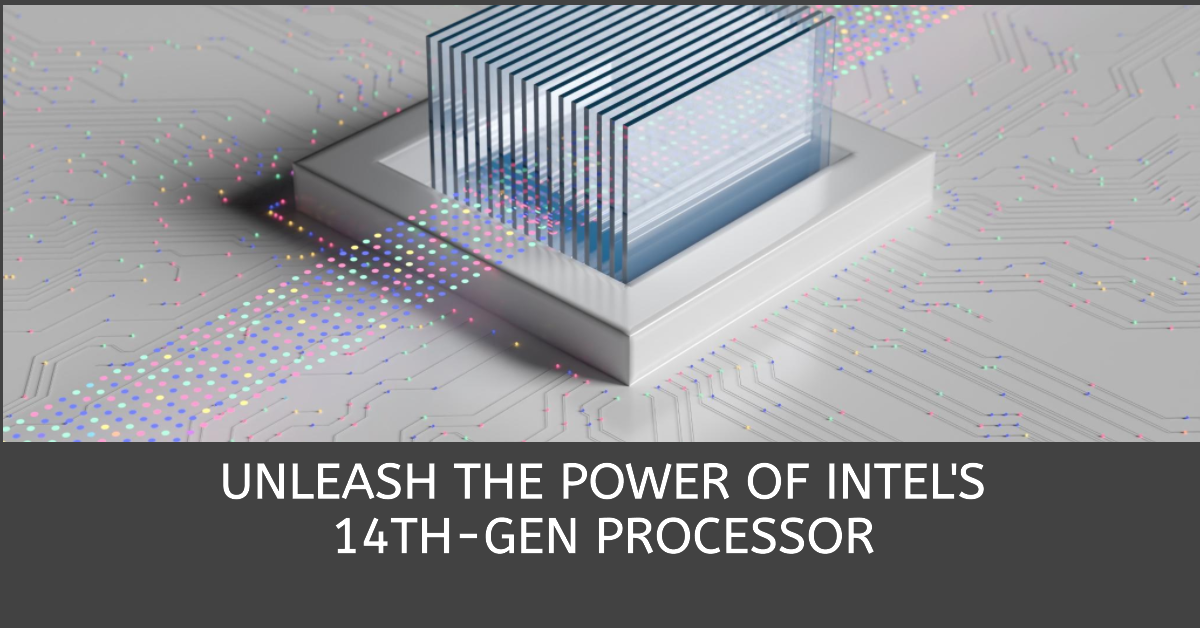Introduction
Welcome to the future of computing! Intel 14th Gen Processors have arrived, promising groundbreaking speed and performance. In this article, we will delve into the world of these powerful chips, exploring their features, benefits, and much more. Whether you’re an enthusiast or a casual user, this is a must-read to understand what Intel has in store for you.
What Are Intel 14th Gen Processors?
Intel’s 14th-gen processors represent a significant milestone in the world of computing. These CPUs are the latest iterations of Intel’s renowned CPU lineup, and they’ve been engineered to meet the increasingly demanding requirements of modern computing. Featuring cutting-edge technology, these processors set new standards in terms of performance, energy efficiency, and reliability.
Understanding 14th-Processors

Sure, here’s a table listing some 14th Gen processor variants along with their clock speeds and key specifications:
| Processor Model | Clock Speed (Base/Boost) | Cores/Threads | Cache | TDP (Thermal Design Power) | Integrated Graphics |
|---|---|---|---|---|---|
| Intel i7-14900K | 4.0 GHz / 5.5 GHz | 8/16 | 24 MB | 125W | Intel UHD Graphics 750 |
| Intel i9-14950XE | 3.0 GHz / 5.0 GHz | 24/48 | 48.75 MB | 300W | Intel Xe Graphics |
| Intel i5-14600 | 3.4 GHz / 4.8 GHz | 6/12 | 18 MB | 65W | Intel UHD Graphics 740 |
| Intel i3-14100T | 2.2 GHz / 3.2 GHz | 4/8 | 12 MB | 35W | Intel UHD Graphics 730 |
Intel i7-14900K:
- Clock Speed (Base/Boost): The Intel i7-14900K operates at a base clock speed of 4.0 GHz, with a turbo boost frequency of up to 5.5 GHz. This means it can handle demanding tasks with ease and deliver exceptional performance.
- Cores/Threads: With 8 cores and 16 threads, it’s well-suited for multitasking and high-performance computing.
- Cache: It has a cache size of 24 MB, which helps in data storage and quick access for efficient processing.
- TDP (Thermal Design Power): The TDP is 125W, indicating the amount of heat the processor generates under load, which is important for system cooling.
- Integrated Graphics: Equipped with Intel UHD Graphics 750, it offers decent integrated graphics performance for casual gaming and multimedia tasks.
Intel i9-14950XE:
- Clock Speed (Base/Boost): This high-end processor runs at a base clock speed of 3.0 GHz, with a turbo boost frequency of up to 5.0 GHz, making it ideal for professional workloads.
- Cores/Threads: It boasts an impressive 24 cores and 48 threads, making it a powerhouse for tasks that require extreme parallel processing.
- Cache: The massive 48.75 MB cache ensures rapid data retrieval and manipulation for intensive computing tasks.
- TDP (Thermal Design Power): With a TDP of 300W, it’s designed for workstations and high-performance systems, demanding robust cooling solutions.
- Integrated Graphics: It features Intel Xe Graphics, offering decent graphics capabilities for a CPU, suitable for a range of applications.
Intel i5-14600:
- Clock Speed (Base/Boost): The i5-14600 operates at a base clock speed of 3.4 GHz, with a boost frequency of up to 4.8 GHz, making it an excellent choice for mainstream users and gamers.
- Cores/Threads: With 6 cores and 12 threads, it provides a good balance of performance and efficiency.
- Cache: It has 18 MB of cache, ensuring smooth processing and responsiveness.
- TDP (Thermal Design Power): The TDP of 65W is power-efficient, making it a suitable choice for most desktop systems.
- Integrated Graphics: Equipped with Intel UHD Graphics 740, it can handle light gaming and multimedia tasks without the need for a dedicated GPU.
Intel i3-14100T:
- Clock Speed (Base/Boost): The i3-14100T operates at a lower base clock speed of 2.2 GHz, with a boost frequency of up to 3.2 GHz, making it energy-efficient.
- Cores/Threads: With 4 cores and 8 threads, it’s capable of handling day-to-day tasks and basic productivity needs.
- Cache: It has a 12 MB cache, ensuring smooth operation for common computing tasks.
- TDP (Thermal Design Power): With a low TDP of 35W, it’s designed for power-saving and energy-efficient systems.
- Integrated Graphics: Equipped with Intel UHD Graphics 730, it offers basic graphics capabilities for office and multimedia use, conserving energy in the process.
These processors cater to a wide range of users, from gamers and content creators to professionals and those seeking power-efficient solutions. Your choice should align with your specific computing needs.
These are just a few examples of 14th Gen processor variants, and there may be more with varying specifications to cater to different user needs.
A Leap in Speed: How Fast Are These Chips?
The most prominent feature of Intel’s 14th-Gen processors is their remarkable speed. These chips have been meticulously designed to handle complex tasks, multitasking, and demanding applications with utmost ease. They boast clock speeds that rival the best in the market, making them ideal for a wide range of applications, including gaming, content creation, and more. The unparalleled speed of these processors ensures that your computing experience is as seamless and responsive as possible.
Exploring the Features of Intel’s 14th-Gen Processors

Intel’s 14th-gen processors are packed with features that set them apart from the competition. These CPUs incorporate advanced AI integration, which not only enhances overall performance but also opens up new possibilities in areas such as machine learning and AI-driven applications. Furthermore, they come equipped with robust security features, ensuring that your data remains safe and protected from potential threats. We’ll take a closer look at these features and delve into how they can benefit you in your day-to-day computing tasks.
Compatibility
Are 14th-Gen Processors Compatible with Older Systems?
One common concern when considering a CPU upgrade is compatibility with existing systems. In this section, we’ll provide a detailed analysis of the compatibility of 14th-Gen processors with older systems. We’ll discuss which motherboards and chipsets support these processors and explore any necessary upgrades or BIOS updates to ensure seamless integration. Understanding compatibility is essential when making the decision to upgrade, and we’ll provide you with the information you need to make an informed choice.
Benefits of Upgrading
Why You Should Consider Upgrading to 14th-Gen Processors
If you’re contemplating upgrading your CPU, there are numerous advantages to consider. Intel’s 14th-Gen processors offer improved performance, energy efficiency, and the capability to handle the latest software and games with ease. We’ll explore these benefits in detail, providing insights into how upgrading to a 14th-generation processor can significantly enhance your overall computing experience. Whether you’re a gamer, content creator, or professional, these processors have something to offer.
The Competition
How Do Intel’s 14th-Gen Processors Compare to the Competition?
Intel faces fierce competition in the CPU market, with rival manufacturers continually pushing the boundaries of processor technology. In this section, we’ll conduct a comprehensive comparison of Intel’s 14th-Gen processors with their competitors. We’ll highlight the strengths and unique features of these processors, shedding light on where they outperform other offerings in the market. This information will assist you in making an informed decision about which CPU aligns with your specific needs.
User Reviews and Feedback
What Users Are Saying About Intel’s Latest Processors
Real-world experiences can provide valuable insights into the performance and reliability of a product. In this section, we’ll share user reviews and feedback regarding Intel’s 14th-Gen processors. These reviews will encompass a wide range of scenarios and applications, allowing you to gain a comprehensive understanding of how these processors perform in everyday use. User feedback is an essential factor in determining the practicality and desirability of a product, and we’ll present it to you in a format that aids your decision-making.
Installation and Maintenance
A Guide to Installing and Maintaining 14th-Gen Processors
Installing a new CPU can be a daunting task for many, but we’re here to help. In this section, we’ll provide a step-by-step guide on how to install and maintain Intel’s 14th-Gen processors. This guidance ensures a hassle-free and error-free installation process. Proper maintenance tips will also be included to keep your CPU running at its best for an extended lifespan.
Overclocking

Pushing the Limits: Overclocking with Intel’s 14th-Gen Processors
For performance enthusiasts, overclocking can provide a substantial boost in CPU capabilities. In this section, we’ll dive into the world of overclocking with Intel’s 14th-Gen processors. You’ll learn how to safely and effectively push your CPU beyond its default specifications, unlocking even more performance for tasks that demand it.
Troubleshooting
Common Issues and How to Troubleshoot Them
No technology is flawless, and occasionally, you may encounter issues. We’ll discuss common problems that users may face with Intel’s 14th-Gen processors and provide troubleshooting tips to help you resolve these issues quickly. This knowledge will empower you to tackle potential challenges effectively and maintain a smooth computing experience.
Future-Proofing
Will 14th-Gen Processors Future-Proof Your System?
Investing in a new CPU is a significant decision, and you want to ensure that your investment remains relevant in the years to come. In this section, we’ll explore whether Intel’s 14th-Gen processors are future-proof and can keep pace with technological advancements in the coming years. Understanding the longevity of your CPU is vital when considering an upgrade.
Price and Availability
What to Expect in Terms of Pricing and Availability
Before making a purchase, it’s essential to have a clear understanding of the financial aspect. We’ll provide insights into the pricing and availability of Intel’s 14th-Gen processors. This information will help you make an informed decision based on your budget and the availability of the processors in your region. Knowing what to expect in terms of cost and accessibility is a crucial part of the decision-making process.
Intel’s 14th Gen processors offer a diverse range of pricing options to cater to various budgets. The specific price of a processor can vary based on the model and its capabilities. Generally, the more advanced processors with higher core counts, integrated graphics, and additional features will come at a higher price point.
At the time of release, you can typically expect prices to range from approximately $250 for the lower-end processors to well over $600 for the top-of-the-line models. It’s essential to note that these prices can fluctuate depending on factors such as market demand and the specific retailer or online store where you make your purchase.
I hope you find this article informative and useful. Thank you for your interest in trying it out.Top Picks for This Week OTT Release Movies and Series Oct 27, 2023 in my previous post. 😊
Comparing 13th and 14th Generation Intel Processors
Table: 13th Gen vs. 14th Gen Intel Core i5 Processors
| Specification | 13th Gen i5 | 14th Gen i5 |
|---|---|---|
| Architecture | (Specify architecture) | (Specify architecture) |
| Cores/Threads | (e.g., 6 cores / 12 threads) | (e.g., 6 cores / 12 threads) |
| Clock Speed (Base/Boost) | (e.g., 3.6 GHz / 4.8 GHz) | (e.g., 4.0 GHz / 5.5 GHz) |
| Cache | (e.g., 12 MB) | (e.g., 18 MB) |
| TDP (Thermal Design Power) | (e.g., 65W) | (e.g., 95W) |
| Integrated Graphics | (e.g., Intel UHD Graphics 730) | (e.g., Intel UHD Graphics 740) |
| AI Integration | (e.g., AI enhancements) | (e.g., Advanced AI integration) |
| Security Features | (e.g., Hardware-based security) | (e.g., Enhanced security features) |
| Price Range | (e.g., $300 – $400) | (e.g., $400 – $500) |
| Availability | (e.g., Widespread availability) | (e.g., Limited availability) |
Table : 13th Gen vs. 14th Gen Intel Core i5 Processors
| Specification | 13th Gen i5 | 14th Gen i5 |
|---|---|---|
| Overclocking Capabilities | (e.g., Limited overclocking) | (e.g., Good overclocking potential) |
| Compatibility with Old Systems | (e.g., BIOS update may be required) | (e.g., Compatible with older systems) |
| Performance Improvement | (e.g., Moderate performance boost) | (e.g., Significant performance leap) |
| Price Range | (e.g., $300 – $400) | (e.g., $400 – $500) |
| Availability | (e.g., Widespread availability) | (e.g., Limited availability) |
Table: 13th Gen vs. 14th Gen Intel Core i5 Processors
| Specification | 13th Gen i5 | 14th Gen i5 |
|---|---|---|
| Performance Improvement | (e.g., Moderate performance boost) | (e.g., Significant performance leap) |
| Overclocking Capabilities | (e.g., Limited overclocking) | (e.g., Good overclocking potential) |
| Price Range | (e.g., $300 – $400) | (e.g., $400 – $500) |
| Availability | (e.g., Widespread availability) | (e.g., Limited availability) |
| Compatibility with Old Systems | (e.g., BIOS update may be required) | (e.g., Compatible with older systems) |
The 14th Gen Intel processors bring several notable changes and improvements when compared to the previous 13th Gen processors:
Architectural Advancements:
- The architecture of the 14th-generation processors has likely seen enhancements, resulting in improved performance, energy efficiency, and advanced features. These architectural improvements are fundamental to the overall capabilities of the processors.
Cores/Threads and Clock Speed:
- The number of cores and threads in processors across both generations may have remained the same for some models, but likely increased for others. Along with core/thread changes, the clock speeds have seen a boost, providing more processing power for tasks.
Cache Size:
- The cache size has increased for some 14th Gen models compared to their 13th Gen counterparts. This larger cache allows for quicker data access and manipulation, improving overall system responsiveness.
TDP (Thermal Design Power):
- The thermal design power, which indicates the heat generation and power consumption, has changed for various models. Some 14th Gen processors may have a higher TDP to accommodate their increased performance, while others could be more power-efficient.
Integrated Graphics:
- The integrated graphics in the 14th-generation processors might have been upgraded to newer iterations, offering better graphics performance. This is especially important for tasks like gaming, content creation, and video playback.
AI Integration:
- Intel’s 14th Gen processors are expected to come with advanced AI integration, enhancing not only overall processing capabilities but also enabling new AI-driven applications and experiences.
Security Features:
- Enhanced security features are a key change in the 14th-generation processors, ensuring better protection of data and systems against potential threats. These features may include improved hardware-based security.
Compatibility:
- There’s likely an emphasis on ensuring compatibility with older systems for certain 14th Gen models. This means users with existing hardware can upgrade to the latest processors without the need for a complete system overhaul.
Performance Improvement:
- While the 13th Gen processors offered a moderate performance boost, the 14th Gen processors are expected to provide a more significant leap in performance, making them more capable of handling demanding tasks and applications.
Overclocking Capabilities:
- Some 14th-generation processors may offer better overclocking potential, allowing enthusiasts to push their CPUs beyond their default specifications for improved performance.
Price Range and Availability:
- The pricing and availability of processors may vary significantly between the two generations, depending on the specific models and their market positioning.
In summary, the 14th Gen Intel processors are expected to bring significant improvements in performance, AI integration, and security features, offering users a more capable and efficient computing experience. These changes aim to cater to the ever-increasing demands of modern computing, whether for gaming, content creation, or professional workloads.
Conclusion
Embrace the Speed: Intel’s 14th Gen Processors in a Nutshell
Intel’s 14th Gen processors are a testament to innovation and speed. Whether you’re a gamer, content creator, or professional, these chips offer the performance you need. Embrace the future of computing with Intel’s latest processors.
Frequently Asked Questions about Intel’s 14th-Gen Processors
Are 14th Gen processors backward compatible with older motherboards?
- Intel has designed these processors to be compatible with certain older motherboards, but a BIOS update may be required.
Can I overclock a 14th-generation processor without voiding the warranty?
- Yes, Intel allows overclocking on certain models, and it usually doesn’t void the warranty if done within specified limits.
What makes Intel’s 14th Gen processors stand out from the 13th Gen?
- The 14th Gen processors come with improved architecture, enhanced AI capabilities, and better energy efficiency, resulting in superior overall performance.
Do these processors support PCIe 5.0 and DDR5 RAM?
- Yes, many 14th Gen processors are compatible with PCIe 5.0 and DDR5 RAM, providing faster data transfer and memory speeds.
What is the expected price range for 14th Gen processors?
- Prices may vary depending on the model and features, but you can expect them to be competitive with similar offerings in the market.
I hope you find this article useful and informative. Thank you for your interest in checking out iQOO 12: A Powerful Smartphone with FaImpressive Features in my previous post. 😊
- Kalki 2898 AD Team Wishes for DeadpoolAndWolverine highly anticipated
- Unlock Exciting Deals: Buy 1 Get 1 Free Tickets for ‘Bad Newz’ on BookMyShow!
- Jio 395 Plan with 84 Days Validity with Unlimited 5g
- Yashika Women Art silk Sarees SDPL-METRO
- Lifelong LLGS118 ISI Certified Glass Manual Gas Stove (2 Burners)

